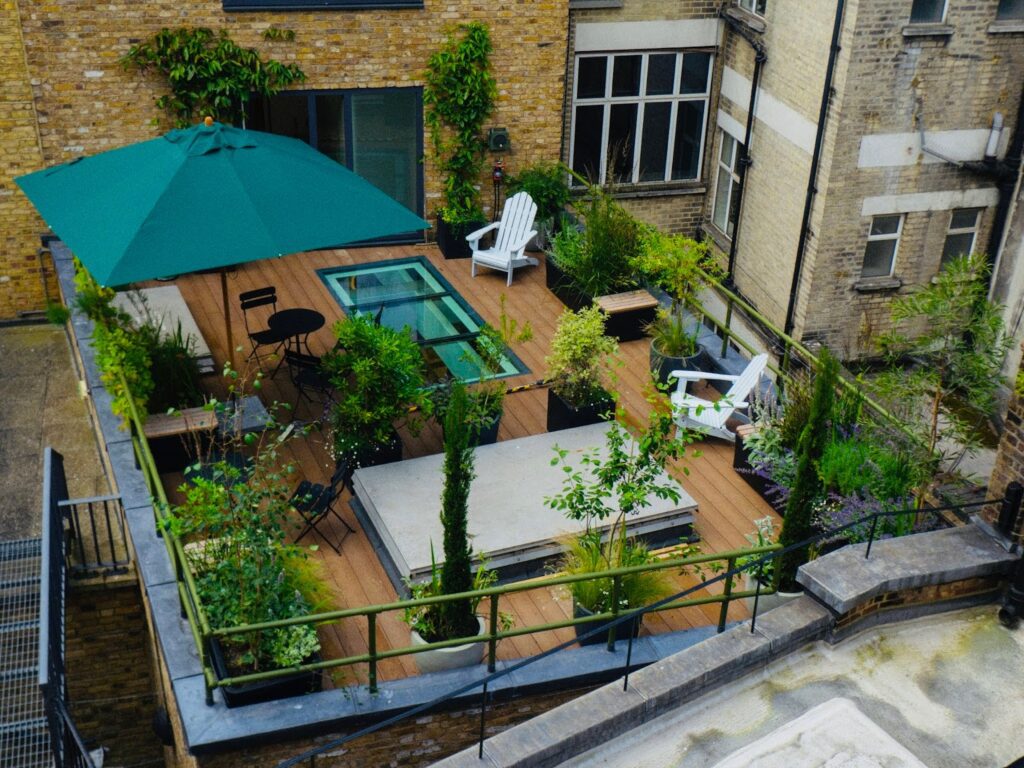In urban environments where outdoor space is often at a premium, roof gardens and terraces offer a unique opportunity to create elevated havens of greenery and tranquility. Think The Highline in New York, Sky Garden in Monument, or the new Crossrail Place Roof Garden at Canary Wharf, these spaces provide an escape from the bustling city. On a smaller scale, they also are a way to incorporate sustainable design and maximise the functionality of your property.
In this article, we discuss the challenges and creative opportunities of designing rooftop spaces, along with tips to help you make the most of your roof garden or terrace.

The first step in creating a roof garden or terrace is ensuring the structure can support the design.
We will always consult with a structural engineer to determine the weight capacity of your rooftop, as the roof loading will guide our choices in materials, plants and features.
Lightweight materials, such as specialist lightweight soil can help minimise the load without compromising aesthetics.
Drainage is another key factor, rooftop spaces must handle rainwater effectively to avoid damage. Considering the drainage system, ensures water flows away efficiently, protecting both your garden and the building.
Our Longchamp Roof Terrace and John Lewis Roof Garden case studies highlight these key considerations.

One of the biggest advantages of a roof garden or terrace is the opportunity to create panoramic views.
Positioning seating areas to establish the best outlooks, whether it’s urban or country life. If privacy is a concern, consider incorporating decorative panels, structural planting or taller planters to create a sense of seclusion without obstructing light.

When space is limited, make every square meter count. Vertical gardening is another excellent solution for adding greenery, while saving room. Living walls, hanging planters, or trellises covered in climbers like jasmine or ivy can bring vibrancy and texture to your rooftop without taking up valuable floor space.

Plants are the heart of any roof garden or terrace, and choosing the right ones is critical. Choose drought-resistant varieties like Sedum, Lavender, and ornamental grasses, which thrive in exposed environments with minimal watering.


Raised beds or large containers are perfect for growing a mix of perennials and evergreen shrubs, creating year-round interest and structure. For a touch of luxury, consider adding small trees like Olive or Acers, which bring shade and elegance to the space.
Beyond plants, roof terraces and gardens benefit from thoughtful features that enhance your outdoor space. Decking, gravel pathways, or tiled areas provide durable surfaces for furniture and foot traffic, while built-in benches or pergolas add functionality and charm.
Lighting is another essential element for creating ambiance and it can transform your roof space into an inviting retreat for evening gatherings. Don’t forget practical additions like storage benches or foldable furniture to make the most of limited space and a firepit or table for ultimate comfort.
Rooftop gardens are not just beautiful, they can also be environmentally considerate. Installing rainwater harvesting systems reduces reliance on mains water, while smart irrigation systems ensure plants receive just the right amount of moisture. Green roofs, in particular, offer ecological benefits by improving insulation, reducing heat absorption and supporting local wildlife diversity. Who knew that some of the best honey in the world comes from cities where hives are placed on key buildings?

Creating a versatile roof garden or terrace is about blending functionality, sustainability, and style to build a space that elevates both your lifestyle and property value. If you are ready to turn your vision into reality, contact us today.
46 St. Lukes Road, Newton Abbot, Devon, TQ12 4ND
Call us today
Email the team



Unique Projects (Devon) Ltd is a company registered in England & Wales. Registered number: 14221838. Registered office: 38 Elizabeth Road, Seaton, Devon, EX12 2DR.